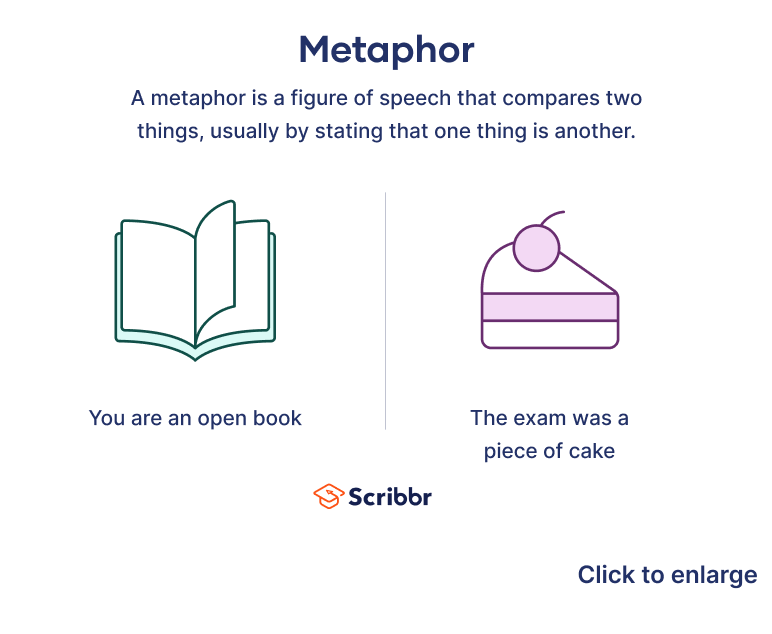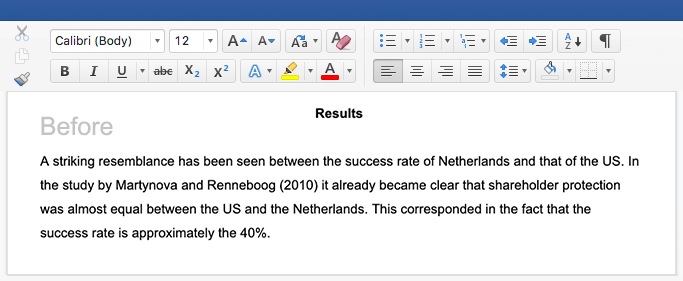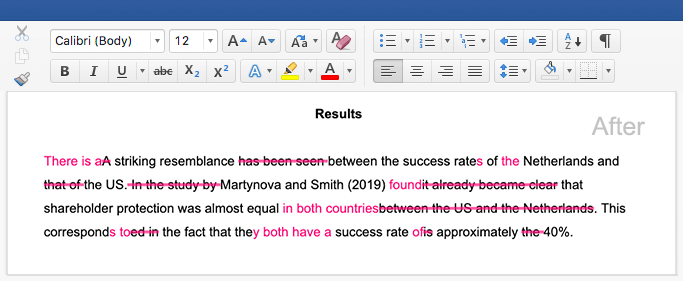What Is a Metaphor? | Definition & Examples
A metaphor is a figure of speech that implicitly compares two unrelated things, typically by stating that one thing is another (e.g., “that chef is a magician”).
Metaphors can be used to create vivid imagery, exaggerate a characteristic or action, or express a complex idea.
Metaphors are commonly used in literature, advertising, and everyday speech.
The exam was a piece of cake.
This town is a desert.
The king ruled with an iron fist.
What is a metaphor?
A metaphor is a rhetorical device that makes a non-literal comparison between two unlike things. Metaphors are used to describe an object or action by stating (or implying) that it is something else (e.g., “knowledge is a butterfly”).
Metaphors typically have two parts:
- A tenor is the thing or idea that the metaphor describes (e.g., “knowledge”).
- A vehicle is the thing or idea used to describe the tenor (e.g., “a butterfly”).
Sophia was a loose cannon.
Time is a hunter.
Types of metaphor
There are several different types of metaphor.
Direct metaphor
A direct metaphor compares two unrelated things by explicitly stating that one thing is another. Direct metaphors typically use a form of the verb “be” to connect two things.
Ami and Vera are two peas in a pod.
A book is a passport to another world.
Implied metaphor
An implied metaphor compares two unlike things without explicitly naming one of them. Instead, a comparison is typically made using a non-literal verb. For example, the statement “the man erupted in anger” uses the verb “erupted” to compare a man to a volcano.
The captain barked orders at the soldiers. [i.e., the captain was like an angry dog]
The politician cut down his opponent with his speech. [i.e., the politician’s words were like daggers]
Extended metaphor
An extended metaphor (also called a sustained metaphor) occurs when an initial comparison is developed or sustained over several lines or paragraphs (or stanzas, in the case of a poem).
Extended metaphors are commonly used in literature and advertising, but they’re rarely used in everyday speech.
And all the men and women merely players.
They have their exits and their entrances,
And one man in his time plays many parts,
His acts being seven ages.
Mixed metaphor
A mixed metaphor is a figure of speech that combines two or more metaphors, resulting in a confusing or nonsensical statement.
Mixed metaphors are usually accidental and are often perceived as unintentionally humorous. Mixing metaphors can confuse your readers and make your writing seem to lack coherence.
She’s a rising star, and with the right guidance, she’ll spread her wings.
Life is a rollercoaster – you need to take it one step at a time.
Dead metaphor
A dead metaphor is a figure of speech that has become so familiar due to repeated use that people no longer recognise it as a metaphor. Instead, it’s understood as having a straightforward meaning.
The guest of honour sat at the head of the table.
On the last leg of the journey, the travellers encountered several obstacles.
Metaphor vs simile
Metaphors and similes are both rhetorical devices used for comparison. However, they have different functions:
- A metaphor makes an implicit comparison between two unlike things, usually by saying that one thing is another thing (e.g., “my body is a temple”).
- A simile makes an explicit comparison between two unlike things, typically using the words “like”, “as”, or “than” (e.g., “you’re as stubborn as a mule”).
The old man’s beard was as white as snow.
The athlete’s will was stronger than iron.
Metaphor vs analogy
There are two main types of analogy:
- Identical relationship analogies indicate the logical relationship between two things (e.g., “‘Up’ is to ‘down’ as ‘on’ is to ‘off’”).
- Shared abstraction analogies compare two unlike things to illustrate a point.
Metaphors are sometimes confused with shared abstraction analogies, but they serve different purposes. While metaphors are primarily used to make a comparison (e.g., “John is a caveman”), shared abstraction analogies are used to make an argument or explain something.
Time is like a river; you cannot stop it from flowing.
Allegory vs metaphor
Metaphors are sometimes confused with allegories, but they have different functions:
- A metaphor makes an implied comparison between two unlike things, typically by stating that one thing is another (e.g., “time is money”).
- An allegory illustrates abstract concepts, moral principles, or complex ideas through symbolic representation.
Allegories are typically longer than metaphors and usually take the form of a story.
Worksheet: Metaphor vs simile
You can test your knowledge of the difference between metaphors and similes with the worksheet below. Choose whether each sentence contains a metaphor or a simile.
- You sing like an angel.
- The boxer is as strong as an ox.
- Hannah is a warrior.
- Your eyes are deeper than the ocean.
- Most of the time, you’re an angel. But you’re like a demon when you’re tired.
- You sing like an angel.
- This sentence contains a simile because it makes a direct comparison using the word “like”.
- The boxer is as strong as an ox.
- This sentence contains a simile because it makes a direct comparison using the word “as”.
- Hannah is a warrior.
- This sentence contains a metaphor because it makes an implicit comparison by saying that something is something else.
- Your eyes are deeper than the ocean.
- This sentence contains a simile because it makes a direct comparison using the word “than”.
- Most of the time, you’re an angel. But you’re like a demon when you’re tired.
- This sentence contains both a metaphor (“you are an angel”) and a simile (“like a demon”).
Frequently asked questions
Cite this Scribbr article
If you want to cite this source, you can copy and paste the citation or click the ‘Cite this Scribbr article’ button to automatically add the citation to our free Reference Generator.
Ryan, E. (2023, October 27). What Is a Metaphor? | Definition & Examples. Scribbr. Retrieved 9 April 2025, from https://www.scribbr.co.uk/rhetorical-devices/metaphor-meaning/




